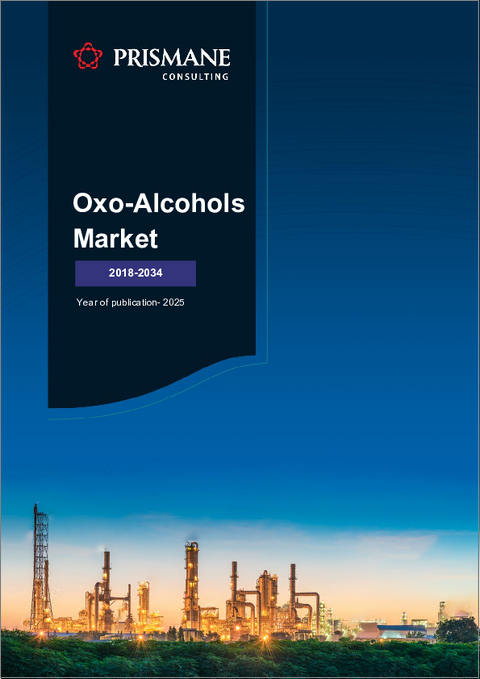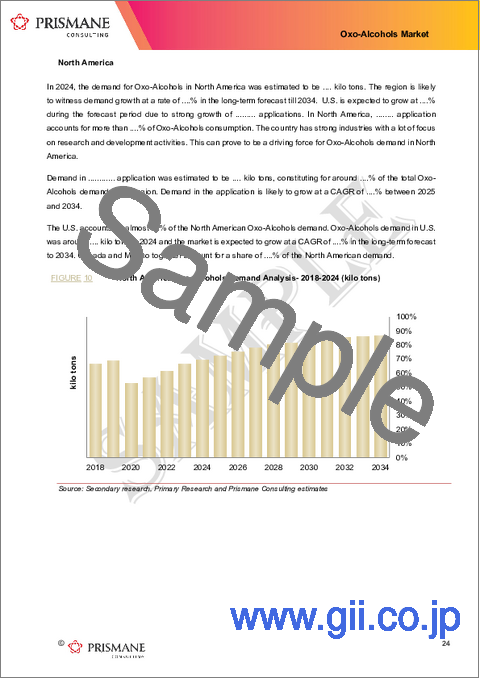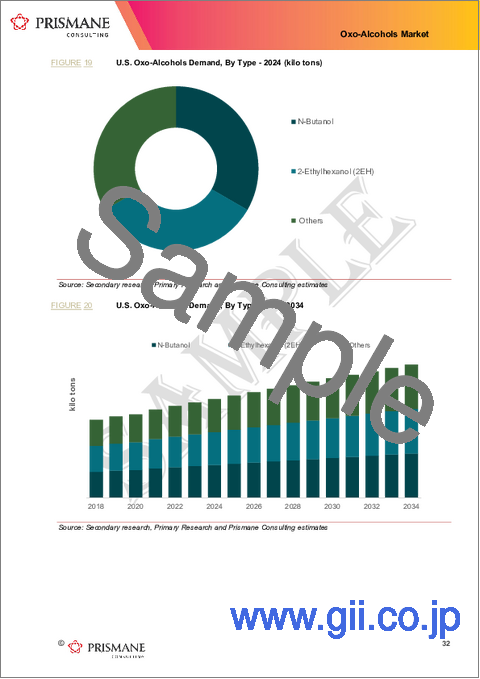|
|
市場調査レポート
商品コード
1771376
オキソアルコールの世界市場の需要、予測分析(2018年~2034年)Global Oxo-Alcohols Market Demand & Forecast Analysis, 2018-2034 |
||||||
|
|||||||
| オキソアルコールの世界市場の需要、予測分析(2018年~2034年) |
|
出版日: 2025年07月09日
発行: Prismane Consulting
ページ情報: 英文 156 Pages
納期: 3~5営業日
|
全表示
- 概要
- 目次
世界のオキソアルコール市場は、多くの最終用途産業の基幹原材料の供給源として機能しています。n-ブタノール、2-エチルヘキサノール(2-EH)、その他の同族体を含むこの化学ファミリーは、可塑剤、酢酸エステル、溶剤、添加剤などの製造に幅広く使用されています。オキソアルコールは汎用性が高くコスト効率に優れているため、プラスチック、コーティング、接着剤、自動車部品、パーソナルケア、医薬品、建材などの生産に欠かせないものとなっています。世界の産業・インフラ活動が拡大するにつれて、都市化や消費者の選好に後押しされ、最終用途部門全体の需要が伸び続けています。
需要:製品タイプ別
n-ブタノールは、溶剤や化学中間体においてバランスの取れた性能を発揮することから珍重される、今なおもっとも広く使用されているオキソアルコールの1つです。塗料・コーティング、インク、接着剤などの用途で重大な、アクリル酸ブチル、酢酸セルロース、酢酸ブチルなどの製品の生産に重要な役割を果たしています。2-エチルヘキサノール(2-EH)は、可塑剤、特にフタル酸ジオクチル(DOP)の生産に用いる主原料であり、エステル系溶剤や潤滑油添加剤にも使用されています。その他のオキソアルコール(イソブタノールやその同族体)は、特殊化学品や洗浄製品などのニッチ市場に供給されています。
需要:用途別
オキソアルコールは、建設、医療、電線・ケーブル用途向けのPVCやその他のポリマーを軟化させる可塑剤に使用されています。酢酸エステル溶剤としては、速乾性の塗料、コーティング、インクを可能にします。工業用溶剤として、洗浄剤、接着剤、アルコール混合物に広く使用されています。潤滑油添加剤においては、これらは機械的ストレスや高温下での性能を向上させます。この他にも、オキソアルコールはエステル誘導体としてフレグランスやローションなどのパーソナルケア製品に、また有効成分の中間体や溶剤として医薬品に含まれています。
最終用途産業の業績
プラスチック・ゴムでは、パイプ、床材、電線絶縁材、医療機器などのPVCベースの材料が需要を促進しています。n-ブタノールと2-EHは依然として重要な構成要素です。建設では、高性能ソリューションに用いられるオキソアルコール系溶剤に依存するコーティング、接着剤、シーラントが使用されています。自動車産業では、オキソアルコールがプラスチック部品、コーティング、オイルの生産に役立っており、特に軽量化された自動車に使用されています。医薬品・パーソナルケアは、純度と規制遵守が最重要であるため、小規模ですが価値の高いセグメントです。
地域の需要の分析
アジア太平洋は、中国、日本、韓国、インド、東南アジアなどの国々における旺盛なPVCと可塑剤の生産により、世界のオキソアルコール市場を独占しています。都市開発と自動車産業の成長により、コーティング、溶剤、プラスチック包装の需要が伸びています。北米と欧州は、確立された工業部門と成熟した規制によって安定した需要を維持しています。ラテンアメリカは、インフラ投資と結びついて安定した需要の伸びを示しています。中東・アフリカは、現地の化学施設が地域のサプライチェーンを強化し、勢いを増しています。
主要メーカー
オキソアルコール市場は、LG Chem、Evonik、BASF、Dow、ExxonMobil、SABIC、Eastman、Shell、Sasol、OXEA、PetroChina、Grupa Azoty、Sinopec、Mitsubishi Chemicalなどの主要化学メーカーが独占しています。
市場力学
オキソアルコール需要の伸びは、フレキシブルPVCから工業用溶剤に至るまで、インフラ、自動車、包装市場と密接に結びついた現代の材料において、製品が極めて重要な役割を担っていることによるものです。技術改良は歩留まりを向上させ、排出を削減し、持続可能性目標に合致しています。特に欧州では、進化するプロダクトスチュワードシップと可塑剤規制が、製品のグレード要件(フタル酸エステルの代替品など)を形成しています。原油価格に連動する原材料の変動はコストに影響を与えます。市場参入企業は、バイオ由来のアルコールやグリーンケミストリーへの投資と、従来の石油化学ルートの拡大とのバランスを取っています。ロジスティクスや生産能力への投資も、地域の成長市場で機敏に対応する必要性を反映しています。
当レポートでは、世界のオキソアルコール市場について調査分析し、市場力学と産業動向、各セグメントの需要、メーカーのプロファイルなどの情報を提供しています。
目次
第1章 イントロダクション
第2章 市場の要約
- 市場の進化
- 需要の概要
- 産業構造
- 戦略上の問題
- 最終用途の動向
- 成長予測
第3章 経済とエネルギーの見通し
- GDPと人口動態
- 金融政策と財政政策
- 原油生産と価格
- 天然ガス
- 電気料金
第4章 最終用途部門の実績
- プラスチック・ゴム
- 建設
- 自動車
- 医薬品
- パーソナルケア
- その他
第5章 オキソアルコールのイントロダクションと市場の概要
- 製品の説明
- グレードと特性
- 原材料
- 製造プロセス
- 環境問題
- バリューチェーン
- 用途
第6章 市場力学と産業動向
- 市場力学
- 促進要因
- 抑制要因
- 機会
- 課題
第7章 世界のオキソアルコール需要の分析:タイプ別、用途別、最終用途産業別(数量と金額)(2018年~2034年)
- 戦略上の問題とCOVID-19の影響
- 需要の分析と予測(2018年~2034年)
- 需要
- 需要成長率
- 促進要因の分析
- 世界のオキソアルコール市場:タイプ別
- n-ブタノール
- 2-エチルヘキサノール(2-EH)
- その他
- 世界のオキソアルコール市場:用途別
- 可塑剤
- 酢酸エステル
- 溶剤
- 添加剤
- その他
- 世界のオキソアルコール市場:最終用途産業別
- プラスチック・ゴム
- 建設
- 自動車
- 医薬品
- パーソナルケア
- その他
第8章 需要の分析と市場のレビュー:地域/国別(数量と金額)(2018年~2034年)
- 戦略上の問題とCOVID-19の影響
- 需要の分析と予測(2018年~2034年)
- 需要
- 需要成長率
- オキソアルコール市場:タイプ別
- オキソアルコール市場:用途別
- オキソアルコール市場:最終用途産業別
- 北米
- 米国
- カナダ
- メキシコ
- 西欧
- ドイツ
- フランス
- イタリア
- 英国
- スペイン
- その他の西欧
- 中欧・東欧
- ロシア
- ポーランド
- その他の中欧・東欧
- アジア太平洋
- 中国
- 日本
- インド
- 韓国
- その他のアジア太平洋
- 中南米
- 中東・アフリカ
第9章 価格分析
第10章 主な戦略上の問題と事業機会の評価
- 市場の魅力の評価
- 見通しとターゲット市場の調査
第11章 戦略的推奨と提案
第12章 企業分析
- オキソアルコールメーカーのプロファイル/企業分析
- 基本詳細
- 本社、主要市場
- 所有
- 企業の財務
- 製造拠点
- 世界の売上
- 総従業員数
- 製品ポートフォリオ/サービス/ソリューション
- 採用された主な事業戦略とPrismane Consultingの概要
- 近年の発展
- 対象企業
- LG Chem
- Evonik
- BASF
- ExxonMobil
- SABIC
- Eastman Chemical Company
- Shell
- Sasol
- OXEA
- PetroChina
- Grupa Azoty
- Sinopec
- Mitsubishi Chemical Corporation
- その他のメーカー
第13章 付録
The global oxo alcohols market serves as a backbone raw material source for many end use industries. This chemical family including n butanol, 2 ethylhexanol (2 EH), and other homologues is used extensively in the manufacturing of plasticizers, acetate esters, solvents, additives, and more. Its versatility and cost effectiveness have made oxo alcohols indispensable in the production of plastics, coatings, adhesives, automotive components, personal care, pharmaceuticals, and construction materials. As global industrial and infrastructure activity expands, demand across end use sectors continues to grow, driven by urbanization, and consumer preferences.
Demand by Product Type
N butanol remains one of the most widely used oxo alcohols, prized for its balanced performance in solvents and chemical intermediates. It plays a vital role production of products such as butyl acrylate, cellulose acetate, and n butyl acetate which are critical in application incusing paints& coating, inks, and adhesives. 2 Ethylhexanol (2 EH) is a dominant feedstock for plasticizer production, particularly dioctyl phthalate (DOP), and is also used in ester-based solvents and lubricant additives. Other oxo alcohols, like iso butanol and higher homologues, serve niche markets in specialty chemicals and cleansing products.
Demand by Application
Oxo alcohols find use in plasticizers to soften PVC and other polymers for construction, medical, and wire and cable applications. As acetate ester solvents, they enable fast-drying paints, coatings, and inks. They are widely used as industrial-grade solvents in cleaning agents, adhesives, and alcohol blends. In lubricant additives, they enhance performance under mechanical stress and high temperatures. Beyond these, oxo alcohols are included in personal care products such as fragrances and lotions for their ester derivatives, and in pharmaceuticals as intermediates or solvents for active ingredients.
End Use Industry Performance
In plastics and rubber, demand is driven by PVC-based materials in pipes, flooring, wire insulation, and medical devices. N Butanol and 2 EH remain key building blocks. Construction uses coatings, adhesives and sealants that rely on oxo alcohol-based solvents for high-performance solutions. In automotive, oxo alcohols help produce plastic components, coatings, and oils, especially in lightweight vehicles. Pharmaceuticals and personal care account for a smaller but high-value market segment, where purity and regulatory compliance are paramount.
Regional Demand Analysis
Asia Pacific dominated the global oxo alcohol market driven by strong PVC and plasticizer production in countries such as China, Japan, South Korea, India and Southeast Asia. Urban development and auto industry growth fuel regional demand for coatings, solvents, and plastic packaging. North America and Europe maintain stable demand due to established industrial sectors and mature regulations. Latin America shows steady demand growth allied with infrastructure investments. The Middle East and Africa are gaining traction, as local chemical facilities boost regional supply chains.
Key Manufacturers
The oxo alcohols market is dominated by major chemical producers such as LG Chem, Evonik, BASF, Dow, ExxonMobil, SABIC, Eastman, Shell, Sasol, OXEA, PetroChina, Grupa Azoty, Sinopec, and Mitsubishi Chemical.
Market Dynamics
Growth in oxo alcohol demand is driven by products' pivotal role in modern materials from flexible PVC to industrial solvents tied closely to infrastructure, automotive, and packaging markets. Technology improvements enhance yield and reduce emissions, aligning with sustainability targets. Evolving product stewardship and plasticizer regulations, particularly in Europe, shape product grade requirements (e.g., phthalate replacements). Fluctuations in raw materials that are linked to crude-oil pricing impact costs. Market players are balancing investments in bio-derived alcohols and green chemistry with scaling traditional petrochemical routes. Logistics and capacity investments also reflect the need to stay agile in regional growth markets.
Table of Contents
1. Introduction
- Scope
- Market Coverage
- Types
- Applications
- End-Use Industries
- Regions
- Countries
- Years Considered
- Historical - 2018 - 2023
- Base - 2024
- Forecast Period - 2025 - 2034
- Research Methodology
- Approach
- Research Methodology
- Prismane Consulting Market Models
- Assumptions & Limitations
- Abbreviations & Definitions
- Conversion Factors
- Data Sources
2. Market Synopsis
- Market Evolution
- Demand Overview
- Industry Structure
- Strategic Issues
- End-use Trends
- Growth Forecast
3. Economic & Energy Outlook
- GDP and Demographics
- Monetary & Fiscal Policies
- Crude Oil Production and prices
- Natural Gas
- Electricity Prices
4. End-use Sector Performance
- Plastics & Rubber
- Construction
- Automotive
- Pharmaceuticals
- Personal Care
- Others
5. Introduction to Oxo-Alcohols and Market Overview
- Product Description
- Grades & Properties
- Raw Material
- Manufacturing Process
- Environmental Issues
- Value Chain
- Applications
6. Market Dynamics and Industry Trends
- Market Dynamics
- Drivers
- Restraints
- Opportunities
- Challenges
7. Global Oxo-Alcohols Demand Analysis, By Types, By Applications, By End-Use Industries (Volume, Value) (2018-2034)
- Strategic Issues and COVID-19 Impact
- Demand Analysis and Forecast (2018- 2034)
- Demand
- Demand Growth Rate (%)
- Driving Force Analysis
- Global Oxo-Alcohols Market, By Types
- N-Butanol
- 2-Ethylhexanol (2EH)
- Others
- Global Oxo-Alcohols Market, By Applications
- Plasticizers
- Acetate Esters
- Solvent
- Additive
- Others
- Global Oxo-Alcohols Market, By End-Use Industries
- Plastics & Rubber
- Construction
- Automotive
- Pharmaceuticals
- Personal Care
- Others
8. Demand Analysis and Market Review, By Region, By Country (Volume, Value), (2018- 2034)
- Strategic Issues and COVID-19 Impact
- Demand Analysis and Forecast (2018- 2034)
- Demand
- Demand Growth Rate (%)
- Oxo-Alcohols Market, By Types
- Oxo-Alcohols Market, By Applications
- Oxo-Alcohols Market, By End-Use Industries
Note: Demand Analysis has been provided for all major Regions / Countries as mentioned below. The demand (consumption) split by types, applications, and end-use industries has been provided for each of the countries / regions in Volume (Kilo tons) and Value (USD Million).
- North America
- USA
- Canada
- Mexico
- Western Europe
- Germany
- France
- Italy
- United Kingdom
- Spain
- Rest of Western Europe
- Central & Eastern Europe
- Russia
- Poland
- Rest of Central & Eastern Europe
- Asia-Pacific
- China
- Japan
- India
- South Korea
- Rest of Asia-Pacific
- Central & South America
- Middle East & Africa
Note: CAGR will be calculated for all types, applications and end-use industries to arrive at the regional / global demand growth for the forecast period (2025 - 2034)
9. Pricing Analysis
10. Key Strategic Issues and Business Opportunity Assessment
- Market Attractiveness Assessment
- Prospective & Target Market Study
11. Strategic Recommendation & Suggestions
12. Company Analysis
- Oxo-Alcohols Manufacturers Profiles/ Company Analysis
- Basic Details
- Headquarter, Key Markets
- Ownership
- Company Financial
- Manufacturing Bases
- Global Turnover
- Total Employee
- Product Portfolio / Services / Solutions
- Key Business Strategies adopted and Prismane Consulting Overview
- Recent Developments
- Companies Covered -
- LG Chem
- Evonik
- BASF
- ExxonMobil
- SABIC
- Eastman Chemical Company
- Shell
- Sasol
- OXEA
- PetroChina
- Grupa Azoty
- Sinopec
- Mitsubishi Chemical Corporation
- Other Manufacturers
Note: This section includes company information, company financials, manufacturing bases and operating regions. Company financials have been mentioned only for those companies where financials were available in SEC Filings, annual reports, or company websites. All the reported financials in this report are in U.S. Dollars. Financials reported in other currencies have been converted using average currency conversion rates. Company profiles may include manufacturers, suppliers, and distributors.
13. Appendices
- Demand - Regions
- Demand - Countries





